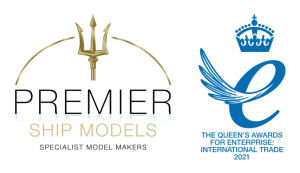In early 2024, we were contacted by an international private client based in the UAE via our social media pages, requesting a custom-made Adastra Yacht model, measuring in at 60 centimetres in length.
This was a welcome challenge for us as the real-life ship is highly futuristic and is of great interest to maritime enthusiasts. The model itself was to be 3D printed and finished by our agent, and the client supplied images and videos for the model to be based off of.
Smaller intricacies were needed, such as the replacement of the logo with custom initials, as well as a different font and colour scheme. Furthermore, the model was to be fitted with a base that would contain a hidden drawer with a note for the receiver, as it was to be presented as a gift by the client to somebody.
The client didn’t want any lights or moving mechanical parts, and an interior wasn’t needed, so this was solely an exterior model complete in an astonishing level of detail.
As stated in the overview, this project was carried out for a private client, and so we will not go into detail. They were thoroughly impressed with the communication and efficiency displayed throughout the project, and they were thrilled with the final result!
It was a joy to help them bring their vision to life and subsequently create a gift for somebody special!
This Adastra Yacht model was to be 3D printed, and it measured precisely 60 centimetres in length (excluding the base).
In terms of materials used, the model was solely constructed from ABS resin, with timber for the base and an acrylic case.
3D-printing is an incredibly complex profession. It requires you to understand three main things:
- The material
- The printer
- The methodology of the piece and your desired end result
The entire process is extremely specialist. Our off-site 3D-printing agent focuses on two skillsets when constructing models: creating the model in a digital manner and readying it for printing, and the separate skillset to take the parts from the printer and get them to a professionally high-standard.
PSM’s custom projects always start with detailed discussions between us and the client to ensure we are properly aligned and can enliven their vision exactly as they imagine. We greatly value transparency; which means we supply all of our clients with regular updates on the progress of their orders, as well as unanimously deciding on things such as delivery schedules and payment terms.
With such a high emphasis on 3D printing, the process begins by creating an initial digital model. We procure high-quality materials as specified in the overview and project brief, and then utilise 3D simulation modelling and laser-cutting for maximum accuracy.
In order to maintain efficiency, we briefly halt production so our clients can approve the digital render or offer feedback. Once approval is received, we proceed swiftly to save both time and resources.
One principally interesting aspect is preparing the digital render for the 3D printer, which requires highly specialised software. We separate the render into manageable sections, each representing a part of the model, and make sure they’re labelled and organised accordingly. Advanced software is used to verify the parts for correct sizing, strength, and waterproofing.
After completing the digital render, we move on to laser-cutting and then start the construction process. This hands-on phase, known as ‘finishing’, necessitates highly skilled and experienced craftsmanship. Typically, we divide the hull of any traditional model into three sections with joints that are glued together and left to dry before adding further details. The hull is primed first to ensure structural integrity.
Meanwhile, our 3D expert prepares and paints smaller components individually.
Throughout the entire process, we keep our clients informed with a plethora of photos and updates. Ensuring our clients’ satisfaction is our utmost priority, and we welcome and incorporate their feedback wherever necessary, to achieve the desired result.
For this particular model, we finished off by engraving the receiver’s initials onto the model in a custom colour and font, as well as fitting the base with a hidden drawer and note. The Adastra Yacht model was then completed with an accompanying acrylic display case, for added protection and longevity.
The client was thrilled with the final model, and couldn’t wait to gift it to the intended party. It was a pleasure to aid them in creating an important memory for somebody, and working on yacht models is always great fun as they allow for plenty of creativity!
We now eagerly await our next project, and are so happy with how this one turned out!
Commission your own model
If you would like to have your own bespoke model built, please complete the contact form below.


